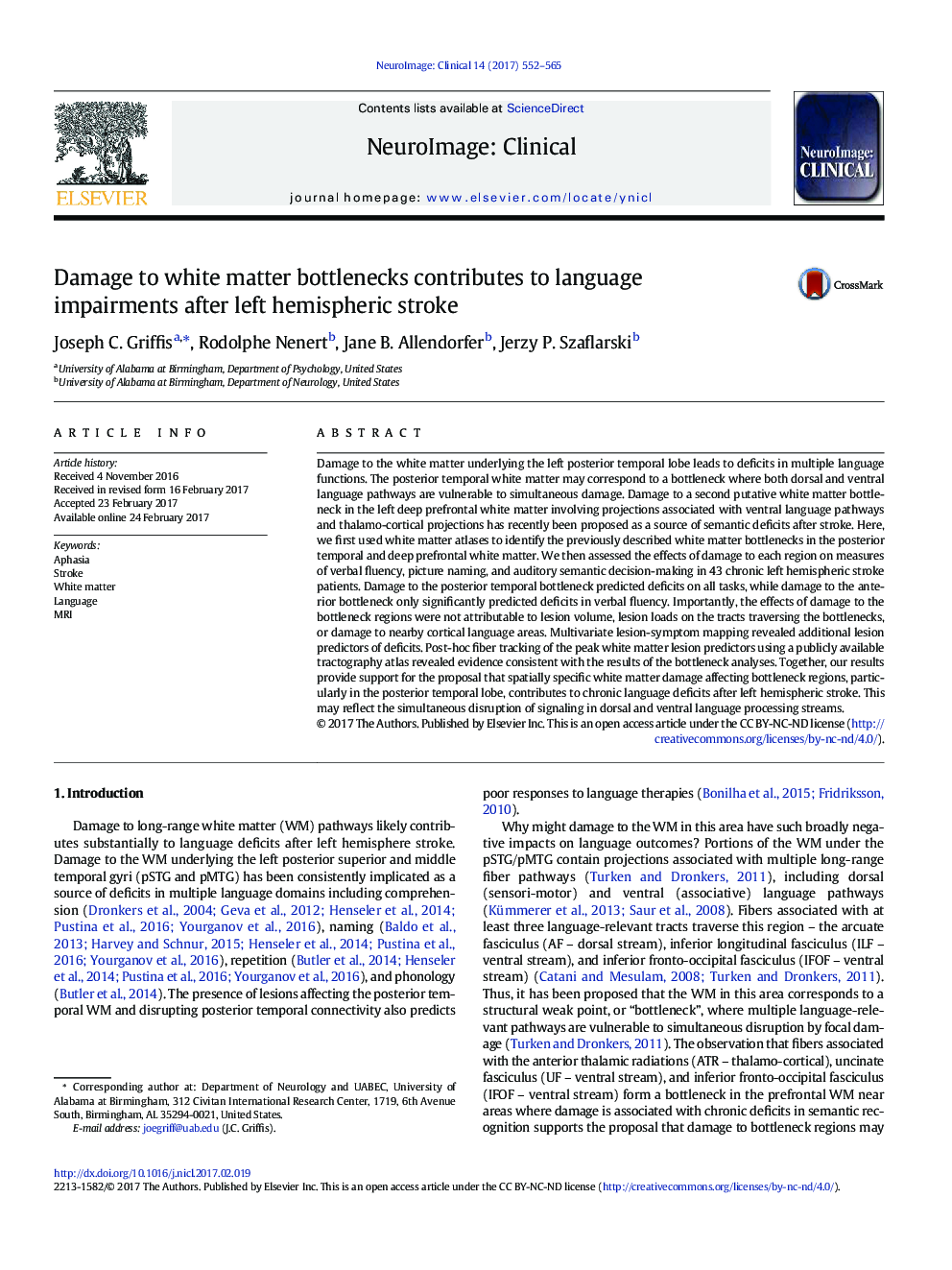| کد مقاله | کد نشریه | سال انتشار | مقاله انگلیسی | نسخه تمام متن |
|---|---|---|---|---|
| 8688745 | 1580953 | 2017 | 14 صفحه PDF | دانلود رایگان |
عنوان انگلیسی مقاله ISI
Damage to white matter bottlenecks contributes to language impairments after left hemispheric stroke
ترجمه فارسی عنوان
آسیب به تنگناهای ماده سفید باعث اختلال در زبان می شود پس از سکته مغزی نیمکره چپ
دانلود مقاله + سفارش ترجمه
دانلود مقاله ISI انگلیسی
رایگان برای ایرانیان
کلمات کلیدی
ترجمه چکیده
آسیب به ماده سفید زیر بغل لبه خلفی چپ منجر به نقص در عملکرد چندین زبان می شود. ماده سفید موقت خلفی ممکن است با تنگنا باشد که در آن مسیرهای زبان پشت و زاویه ای آسیب پذیر هستند تا آسیب های همزمان. به علت کمبود معنایی پس از سکته مغزی، اخیرا به عنوان یک منبع کمبود معنایی پیش بینی شده است که آسیب به ماده تاریک ماده سفید پیش بینی شده در ماده ی سفید سفید پیش ماده پیشانی، شامل پیش بینی های مربوط به مسیرهای زاویۀ زبان و پیش بینی های تالامو کورتیکال است. در اینجا، برای اولین بار از وانتهای ماده سفید استفاده شدیم تا تنگناهای ماده سفید که قبلا شرح داده شده بود در مواد سفید سفید پیشانی و عمیق خلفی شناسایی شود. پس از آن، اثرات آسیب به هر منطقه بر روی اقدامات روایی کلامی، نامگذاری عکس و تصمیم گیری معنایی شنیداری در 43 بیمار مبتلا به سکته مغزی نیم تنه چپ مزمن بررسی شد. آسیب به تنگنای موقتی خلفی پیش بینی کمبود در تمام وظایف، در حالی که آسیب به تنگنا قهوه تنها به طور قابل توجهی پیش بینی کمبود در روایت کلامی. مهم این است که اثرات آسیب به ناحیه تنگنا ناشی از حجم ضایعه، بارگذاری ضایعات در دستگاه های عبور از تنگناها یا صدمه به ناحیه زبان کورتیکال نیست. نقشه برداری ضایعات چند جانبه نشان دهنده ضعف های اضافی بود. ردیابی فیبر پس از فاکتورهای پیشگیری از ضایعات قله سفید با استفاده از یک آثار رسمی عمومی آثار با شواهد منطبق با نتایج تجزیه و تحلیل تنگنا نشان داد. با هم، نتایج ما حمایت از این پیشنهاد را ارائه می دهد که آسیب ناشی از مواد مکانیزه سفید خاصی که در مناطق تنگنا رخ می دهد، به خصوص در لوب قدامی خلفی، به کمبود مزمن زبان بعد از سکته نیم کره چپ کمک می کند. این ممکن است منعکس کننده اختلال همزمان سیگنالینگ در جریان پردازش زبان پشت و شکمی باشد.
موضوعات مرتبط
علوم زیستی و بیوفناوری
علم عصب شناسی
روانپزشکی بیولوژیکی
چکیده انگلیسی
Damage to the white matter underlying the left posterior temporal lobe leads to deficits in multiple language functions. The posterior temporal white matter may correspond to a bottleneck where both dorsal and ventral language pathways are vulnerable to simultaneous damage. Damage to a second putative white matter bottleneck in the left deep prefrontal white matter involving projections associated with ventral language pathways and thalamo-cortical projections has recently been proposed as a source of semantic deficits after stroke. Here, we first used white matter atlases to identify the previously described white matter bottlenecks in the posterior temporal and deep prefrontal white matter. We then assessed the effects of damage to each region on measures of verbal fluency, picture naming, and auditory semantic decision-making in 43 chronic left hemispheric stroke patients. Damage to the posterior temporal bottleneck predicted deficits on all tasks, while damage to the anterior bottleneck only significantly predicted deficits in verbal fluency. Importantly, the effects of damage to the bottleneck regions were not attributable to lesion volume, lesion loads on the tracts traversing the bottlenecks, or damage to nearby cortical language areas. Multivariate lesion-symptom mapping revealed additional lesion predictors of deficits. Post-hoc fiber tracking of the peak white matter lesion predictors using a publicly available tractography atlas revealed evidence consistent with the results of the bottleneck analyses. Together, our results provide support for the proposal that spatially specific white matter damage affecting bottleneck regions, particularly in the posterior temporal lobe, contributes to chronic language deficits after left hemispheric stroke. This may reflect the simultaneous disruption of signaling in dorsal and ventral language processing streams.
ناشر
Database: Elsevier - ScienceDirect (ساینس دایرکت)
Journal: NeuroImage: Clinical - Volume 14, 2017, Pages 552-565
Journal: NeuroImage: Clinical - Volume 14, 2017, Pages 552-565
نویسندگان
Joseph C. Griffis, Rodolphe Nenert, Jane B. Allendorfer, Jerzy P. Szaflarski,
